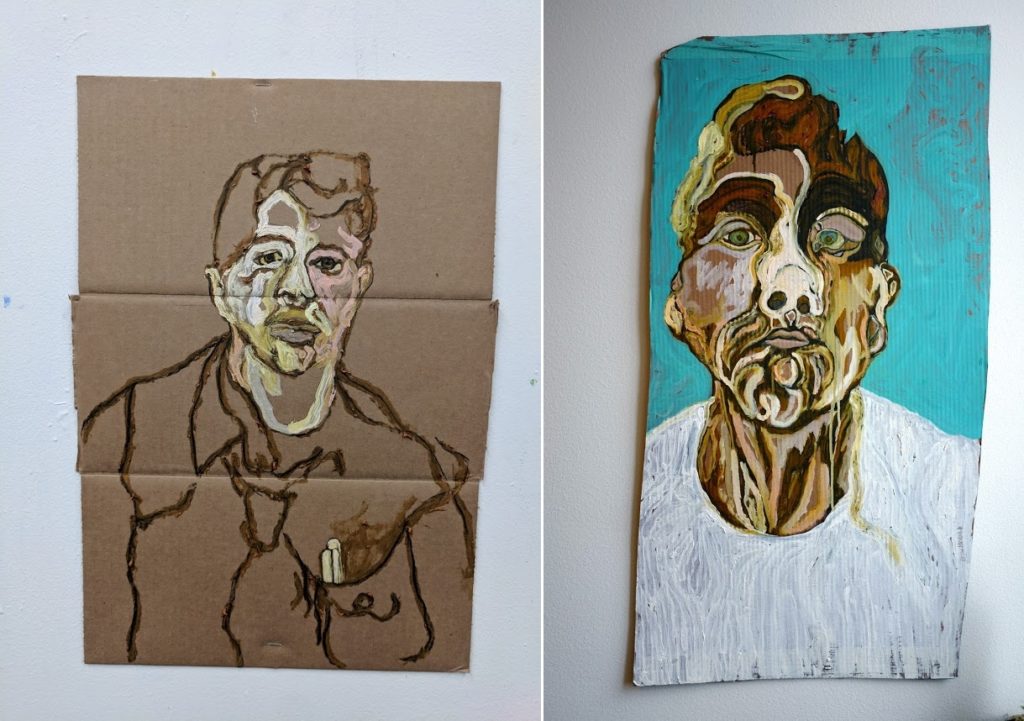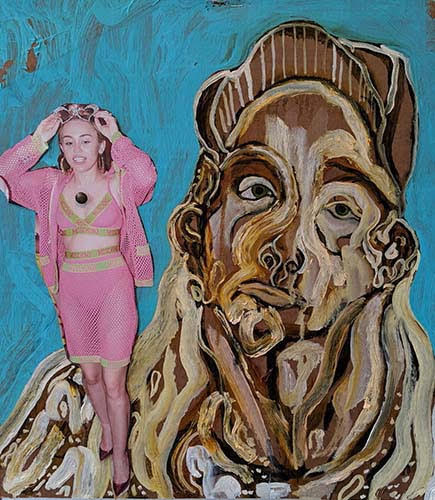The Internet as a Palette: An Interview with Gretchen Andrew

The role of the internet and our trust in it is a question that has sparked unprecedented discussion in 2019. Social media, Cambridge Analytica, and the use of personal data–now worth more than oil–has amounted to a huge amount of skepticism and distrust of a technology that we use every minute. LA artist Gretchen Andrew does away with this cynicism, renegotiating the internet into a positive force for innovative and deconstructive art. Like a modern post-structuralist, Andrew’s work uses the very medium that she critiques: Google.
The best way to understand Andrew’s work, is to load up Google Images and search “Frieze Los Angeles.” On first glance, results from the Frieze Art Fair appear to show the artist’s paintings on display. However, the critical eye will notice that the Frieze carpet looks too polished and the walls appear graphically generated. The images are entirely fake. Andrew’s appearance at Frieze only came to fruition through her own computer. The beauty of Andrew’s work is the moment of realization that we understand the fictitious nature of the piece–but Google doesn’t. She calls this “Internet Imperialism.” In doing this, Andrew has designed a future where she is featured at Frieze, the Whitney Biennial and the recipient of the Turner Prize.
Andrew’s work is an expression of how we all use the internet to curate our own desires and identities, whether that be featuring at Frieze Art Fair or using a simple Snapchat filter. The effect is a body of work that makes explicit the ambiguities behind Google, taking the power away from those with commercial interests, and giving it to artists in search of a new medium. We spoke to Gretchen about her work, what it means for the future of digital art, and the implications of internet manipulation:

What is Internet Imperialism?
Internet Imperialism is a term I invented to describe my art practice of manipulating search results with my paintings in a way humans can understand but technology cannot. Recently I have been working a lot with desire and looking at how Google can’t tell the difference between me saying “I want you in my future” and “I have you right now.”
I’ve just completed a project around The Turner Prize and earlier this year my Frieze Los Angeles project dominated Google’s results in conjunction with the debut of the Frieze Los Angeles art fair. Along with my Whitney Biennial 2019 these projects are part of a series titled It’s My Future…and I Want You There, which includes paintings about places, feelings, and people that I want in my future — all presented inside manipulated search results that make it appear as if this future has already happened.

What are the social implications of your work?
Understanding desire is central to my work and the internet is just one of many systems that abstracts us from understanding, accepting and pursuing what we want. Like any system, it has a set of rules and conditions that can be we take varied degrees of ownership over.
In terms of data, privacy, and artificial intelligence there are parallels to the way we’ve treated the environment. By not bothering to understand technology we are setting the future up to spend a great deal more time and money trying to undo the damage we currently carelessly causing, both as corporations and consumers/end users. In using my work to expose how the internet works, and who it is more likely to work for, I am hoping we can get to the point where we all accept responsibility more quickly.

Are you exposing someone who could do this in a negative light?
I do think it’s negative to be content to let others create the world in which you live, this touches on everything from capitalism and democracy to our individual relationships as how power works online is a conduit for power more generally. The alternative, creating your own world, is exhausting and potentially painful but there’s a lot of joy in that freedom. I think you have to have a lot of confidence too, both that your vision of the world is worth imposing on others but also that those subjected to it don’t care enough to create their own. That’s the great thing about being an internet imperialist artist instead of a political dictator. I’m sort of obsessed with rules, where they come from, and how many prisons are of our own making.

The work appears to coincide with the culture of “fake news,” is this lack of trust in technology something you’re exposing?
The internet can be seen as a global subconscious and, much like our own subconscious, it cannot tell the difference between a hoped-for future intensely imagined during meditation or hypnosis and what has, in fact, already occurred. By talking about what we want the future to be like we can make Google give it to us now. We can see this as a technical failure or as an asset, as tangential to “fake news” or in line with the history of computers as dream machines a la J.C.R. Licklider. If we think of the internet like the artistic and creative medium I believe it is we begin to realize that demanding accuracy from it is misguided. Conversations about art are generally not served by real vs fake as much as by nuance, opinion, perspective, and metaphor. I am really excited to be working on my first museum solo exhibition with the Monterey Museum of Art set to open in July 2020. I’m calling it Future News and it addresses this exact question during the run to the US election. You can follow that project “Cover of Artforum.”
How much of your work is about not just Google’s lack of understanding but our own?
If we only read the headlines and don’t dive in then we aren’t doing the full evaluation. If you look closely, especially with the Frieze piece, it looks fake, it looks like a constructed CGI space. Without a critical eye you can easily miss that. Even the Whitney Biennial vision board project, it is much easier to see that I have cut out previous guests and I am gluing things. You only have to take half a second and you can see that it is a crafty piece of collage and not a real exhibition space. I try to keep those hints as visible as possible. There is a piece I have right now–when you search for the “Lumen Prize,” which is a digital art prize that I submitted work to be a takeover of the Lumen Prize. I did not make the entry, but still when you search “Lumen Prize” my work appears. With the paintings, I show all the edges, I show that they are painted on cardboard with no context. The role is to make it intelligible to humans but not to Google.
Are you hopeful about the future of artificial intelligence?
I am not hopeful that those with the ability to be thoughtful will be; there is too much money to be made. But I try to keep hope at the center of my practice. I use my paintings to explore a bottom-up, unsolicited, non-insider, semi-supervised, end-user reeducation of machines, hopefully teaching them to dream wider than our current reality. Right now, most machine learning/AI systems are learning based on the world we have instead of the ones we hope for. Art is a form of possibility. Just as it can inspire humans into awe and appreciation for others, so it can for machines. I am hopeful about art and hopeful about the power of desire.
I think dreams are important to the ethos of computing and I’m interested in connecting with technology leaders who remember this. Artists have always used their work to create and invite others into potential worlds. A central idea in my work is that we can use the dream ability of technology in alignment with its failures to collectively create, understand, and build the future.

What role with AI have in the world of art?
Much of the artwork now associated with AI creates new artificial intelligence or makes artwork from AI. In contrast my work approaches the problem of disproportionately commercially-motivated inputs into Google’s search neural net by creating art-driven, distributed, end-user changes to machine intelligence. By organizing and structuring diverse, inclusive, and positive content as an end-users I can change how artificial intelligences are being educated. The relationship between humans and intelligent machines can sometimes be understood as between parents and children where the children also have much to teach us about our own limitations and failures. Personally, I am not interested in making work that is so literally about or from AI. AI is only a new system of control, power, and institution. I’d like more artists to find roots in this history as I think it would be more interesting than presuming we are having a totally new conversation.

How do you get the audience to view the digital performance piece?
Search Engine Art is a form of performance in that it deals with time and timing, and getting the results to appear at a specific time is an art, not a science. The complexity of the work is well illustrated by the difficulty in sharing work that exists in time but not space. One way I deal with this is to use Rhizome Webrecorder to document the performance over time.
Who are some artists that you have drawn inspiration from?
I find it a great privilege to be a fan of those you love. It is this love more than any particular work or practice that inspires me. I get to spend a lot of time with artists, not just visual artists but musicians, directors, people who are often both. And the best ones inspire you by their openness, uncapitalized sense of time, and courageous intertwining of work and life.
Featured Image: Whitney Biennial 2019. Photo courtesy of the artist.


